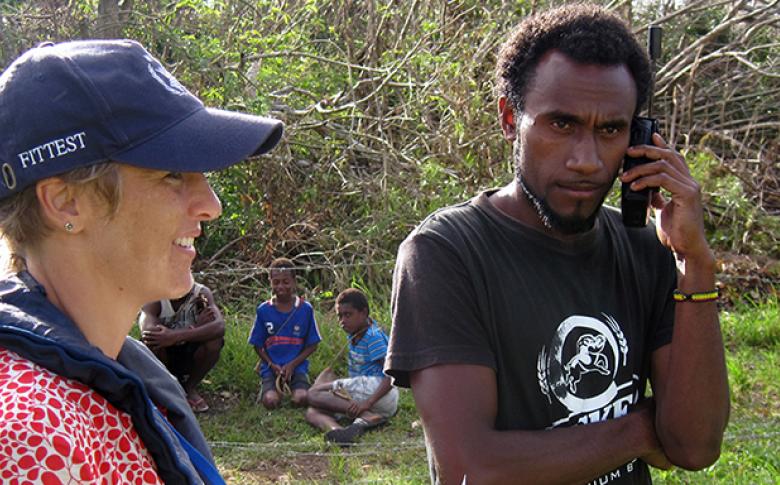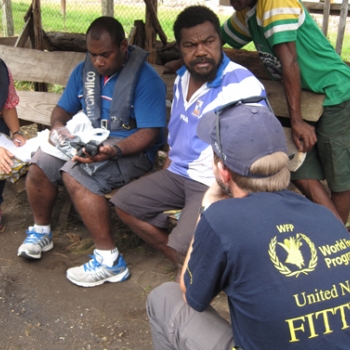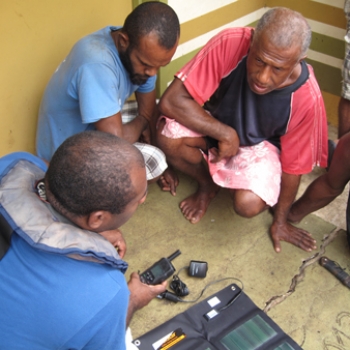Reconnecting After Cyclone Pam

Within hours of Cyclone Pam tearing through Vanuatu, the critical need for communications was blaringly obvious. Why? With the exception of the capital, Port Vila on Efate Island, the other 64 inhabited islands that comprise the country were largely incommunicado. Without communications, there was no way of knowing the impact this Category 5 storm had made on the small island nation.
The Emergency Telecommunications Cluster (ETC), led by the World Food Programme (WFP), was requested by the Government of Vanuatu to support the communications response to Cyclone Pam. In close cooperation and coordination with the government, the ETC and its network of partners provided shared internet connectivity services at nine sites across Vanuatu. Now, just three weeks after Cyclone Pam, sites are already being decommissioned as the country quickly recovers.
Supporting Government Needs

Prior to the cyclone, commercial companies provided phone and internet services to the population, and the Government of Vanuatu had a dedicated network between the capital and the six provincial capitals. Cyclone Pam decimated all communications networks.
"The government, very capable and competent, was gratefully overwhelmed by the offers for support," says Oscar Caleman, WFP FITTEST Specialist, deployed as ETC Coordinator in Vanuatu. "They had never faced such a massive emergency response by the international community before, where there has been so many actors wanting to provide aid. The ETC has the experience in responding to large-scale emergencies, so our focus is to help the Chief Information Officer (CIO) pin down needs, we take that back to the ETC network of partners, identify and match organisations that can support them and then present the solutions back to the government."
"The ETC has been an amazing resource to us in this post crisis period," says Fred Samuel, CIO of the Prime Minister's Office, Government of the Republic of Vanuatu. "A great deal of technology companies have responded and sent specialists and equipment immediately.
"We have been delighted with the speed to assist, the professionalism of the team and their initiatives. We could not have recovered emergency communication solutions as quickly without the support of the ETC," says Fred.
Two-Step Approach to Connectivity
With such massive destruction to the communications infrastructure, the first step was to provide an immediate connectivity solution. Small portable satellite terminals, ‘BGANs', and satellite phones were distributed to key government personnel allowing them to communicate urgent needs.
ETC member, Telecoms Sans Frontieres (TSF), arrived on the ground within 24 hours of the cyclone along with the UN Disaster Assessment and Coordination (UNDAC) team. "We arrived here to support the UNDAC team with satphones and BGANs," says Sebastian, Head of Mission for TSF in Vanuatu. "We provided internet in the National Disaster Management Office and a hotel in Port Vila, and then in more remote locations where the government said it was needed."
Now in week four of the response, satellite phones have been given to the government by the ETC and TSF, and portable satellite terminals have been replaced with more robust equipment in key operational areas. Both experts advisors and equipment from WFP and TSF, as well as, ETC members emergency.lu, Ericsson Response, Swedish Civil Contingencies Agency (MSB), NetHope and their partner BT are working round-the-clock to support the response. Through its network of partners, the ETC will provide internet connectivity services until commercial and government networks are back online and operating at full service.
The Challenges
Of the total population of 250,000 people, 160,000 were affected across the 65 inhabited islands. Communities are spread into tiny population pockets that consist of as few as three families. The only way to access these areas is by helicopter.
"You had to be on the islands to get an idea of what was going on," says Oscar. "There are extremely remote areas. In the first days we were flying around islands, handing out satphones and training medical personnel or the elder in the village on how to use it and whom to call."
As well as destroying communications infrastructure, Cyclone Pam also severely damaged power grids across the country. Up until now, the operation is dependent on solar power and generators to charge communications equipment.
 Preparing for the next emergency
Preparing for the next emergency
"WFP's mandate for the last decade has been to provide communications services to the humanitarian community," says Oscar. "For the next ten years though, this will change and working with governments to build resilience to emergencies is one of the areas we will be focusing on."
"The encouraging thing about this operation is that in about two months they won't need us anymore. The local service providers are recovering extremely quickly, and the government is getting back on its feet," says Oscar. "If we do stay, it will be to work with the government to build capacity and prepare for the next emergency. But generally, they've got it from here."
By Mariko Hall, Global ETC Cell